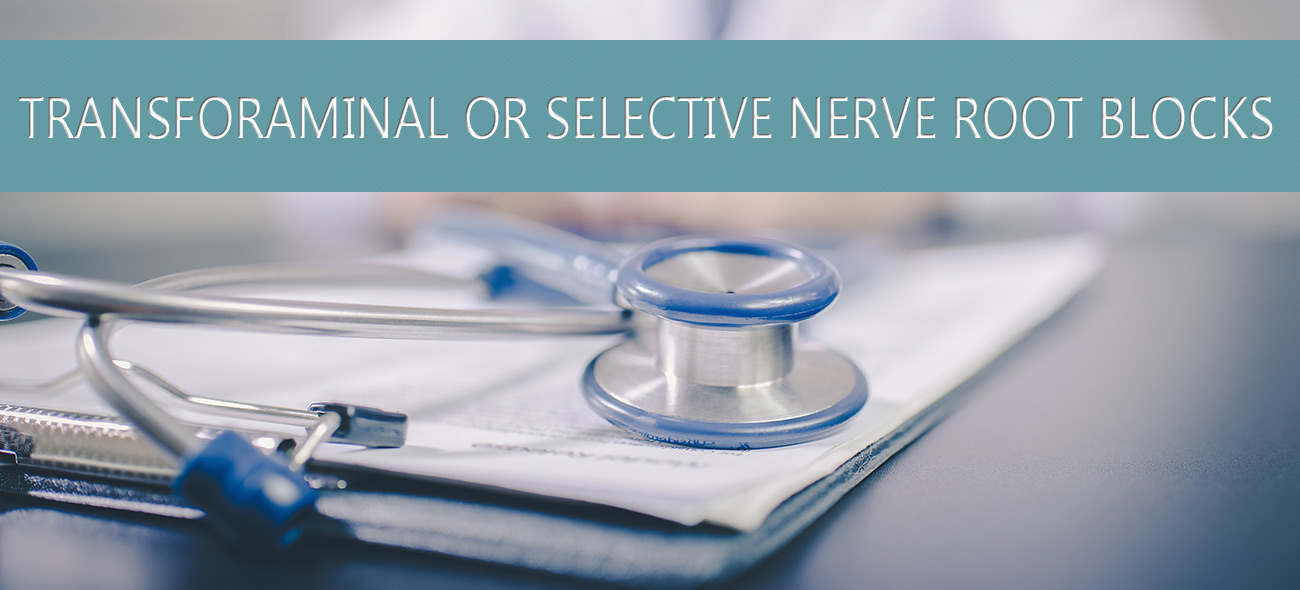Transforaminal or Selective Nerve Root Blocks
Description
A transforaminal or selective nerve root block is an injection of local anesthetic and steroid injected under x-ray guidance into the area where the nerve exits the spinal column. A block is usually ordered by your doctor for pain in the arm or leg that follows the path of a single nerve. This block may be diagnostic and/or therapeutic. One of three things may happen. 1. The pain does not go away – which means that the pain is probably not coming from the nerve at the level of the injection – this has diagnostic value. 2. The pain goes away and stays away for a few hours but the original pain comes back and doesn’t get better again. This would mean the block was also of diagnostic value – the pain is probably coming from the nerve at the level of the injection, but the steroid was not of benefit. 3. The pain goes away after the block, the pain may come back later that day, but then the pain gets better again over the next few days. This means that the block was of therapeutic value – the steroid had a long lasting effect on the pain. If you get good, lasting benefit from the injection, the block may be repeated. Sometimes your surgeon will ask that the block be done to help identify whether or not surgery might be helpful and at what level the surgery might be most helpful.
Note: The procedure can not be performed if you have an active infection, flu, cold, fever, very high blood pressure or if you are on blood thinners. Please make you doctor aware of any of these conditions. This is for your safety!
Risks of the procedure
As with most procedures there is a remote risk of bleeding, infection, nerve injury, or allergic reaction to the medications used. Some short-term side effects may occur. You should get some numbness that follows the path of the nerve that was blocked. You may get some weakness as well. If you get weakness that interferes with your ability to walk, you will have to remain in the Ambulatory Surgery Center until this resolves – usually several hours. You may have increased pain for a few days after the injection, including localized pain at the injection site. Diabetics may have short-term elevation of blood sugars. People prone to fluid retention may have increased fluid retention for 1 – 2 weeks.
Most people say the stinging/burning of the numbing medicine is the most uncomfortable part of the procedure though every person’s response to any procedure is individual. As the injection is right near a nerve it is possible to get a temporary “electric-shock” sensation.
The procedure
After signing a consent form, checking your vital signs and starting an IV if needed, the procedure will be done in the fluoroscopy (x-ray) room with you lying on your stomach. The back is the cleansed with an antiseptic soap. Sterile drapes are placed. The skin is anesthetized (numbed) with a local anesthetic. This is felt as a stinging or burning sensation. Using x-ray guidance, the needle is advanced to the proper location. A dye may be injected at this point (Please let the doctor know if you have an allergies to dye). Local anesthetic and steroid are then injected through the needle and the needle is removed. Your skin will be cleansed and a bandage will be applied if needed. (The bandage can be removed the next morning). Your blood pressure will be checked and you will be discharged to leave with your ride after M.D. authorizes discharge.
After the procedure
Your pain may be improved immediately after the injection from the local anesthetic. It is important to keep track of how you feel for the remainder of the day. The steroid usually takes two or three days to have an effect in most people and peaks in about two weeks. Some local tenderness may be experienced for a couple of days after the injection. Using an ice pack three of four times a day will help this. You may take your usual pain medication as well after the injection. It is important that you keep track of the amount of pain relief you received as well as how long the pain relief lasted.
Restrictions
You may not drive for the remainder of the day after your procedure. It is best for an adult to be present to drive you home or to go with you in a taxi or on public transportation. This is for your safety. No heat is to be used in the injected area for the remainder of the day. No tub bath or soaking in water (i.e. pool, jacuzzi, etc.) for the remainder of the day. Take your medications as usual with a sip of water but do not eat for for 2 hours before the procedure. Please follow the above instructions unless told differently by your doctor.
Notify your doctor If you experience severe back pain, new numbness or weakness of your legs, or signs of infection in the area of the injection, you should call your doctor at: 301-530-7303 or go to the nearest emergency room.

